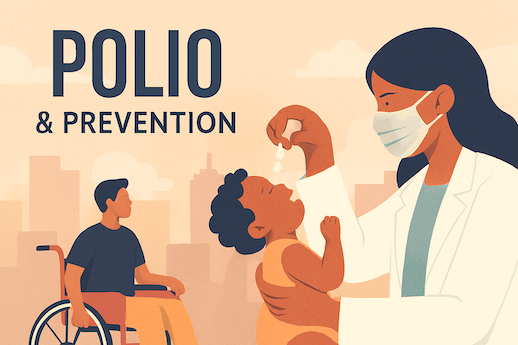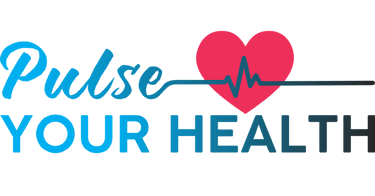Stay updated on what is trending in health. Discover tips and resources for a healthier, balanced life.
Polio: Symptoms, Prevention, and the Path to Eradication
Learn about polio—its symptoms, causes, transmission, and global prevention efforts. Discover how vaccines protect and how close we are to global eradication.
DISEASES AND CONDITIONS
Dr. S. Ali
10/6/20257 min read


If you’ve heard of polio, you know it used to be a big fear—kids getting paralyzed, sometimes dying. These days, because of vaccines, it’s rare in many countries. But “rare” doesn’t mean “gone.” Polio still matters. Let’s break down what it is, how it spreads, how you can protect yourself, and what the world is doing about it.
What is Polio?
Polio, or poliomyelitis, is a disease caused by a virus. The virus loves to attack the nerves, especially the nerves in the spinal cord and brainstem. Those nerves are what help you move, swallow, breathe. So when polio gets serious, it can paralyze muscles. In worst cases, the muscles that control breathing are affected.
Most people who catch the polio virus never even feel sick. Yep, it’s sneaky. About 70-90% of infections cause no symptoms at all. When there are symptoms, they often start like a mild flu: fever, sore throat, headache, maybe stomach upset. Only a small portion of people go on to more serious illness.
Why it Matters
Even though paralysis is rare (about 1 in 200 infections leads to irreversible paralysis), when it strikes, the damage can be permanent.
Among those paralyzed, some may lose the ability to breathe on their own. Without medical support, that can be life-threatening.
There’s no cure for polio once it’s active. Treatment focuses on supportive care: helping you breathe, physical therapy, preventing complications. Prevention is everything.
How Polio Spreads
Understanding how polio spreads helps you see both why it’s prevented by vaccination and why clean water and hygiene matter a lot.
The main route is faecal-oral: that means swallowing something contaminated with infected stool. Could be food, water, dirty hands.
It can also spread through the throat (respiratory route), though that’s less common. Coughs or sneezes when someone is infected may play a role.
Someone infected may not feel or look sick, but can still shed virus (in feces) for days or weeks. That means they can unknowingly spread it.
Areas with poor sanitation, crowded living, unsafe water, and low vaccine coverage are especially at risk.
Types of Polio Illness
Asymptomatic infection
Polio doesn’t affect everyone in the same way. In fact, most people who get infected never even know it. This is called asymptomatic infection, where the virus is present in the body but causes no noticeable illness — though the person can still spread it to others.
Abortive or mild polio
A smaller group of people develop what’s known as abortive or mild polio, which feels a lot like the flu. Symptoms may include fever, fatigue, sore throat, headache, or stomach upset. According to the Mayo Clinic, this is the most common form among those who do develop symptoms.
Non-paralytic polio
In some cases, the infection progresses to non-paralytic polio, where symptoms become more intense. People may experience neck or back stiffness, muscle aches, and sensitivity to light, but there is still no paralysis. This stage is less common than the mild form.
Paralytic polio
The most severe type is paralytic polio, where the virus invades the motor nerves that control movement. This can lead to muscle weakness or paralysis, most often in the legs, but sometimes in the face, throat, or chest muscles. Although this form is rare—occurring in roughly one out of every 200 infections—it has the most serious and long-lasting consequences (Encyclopedia Britannica, Johns Hopkins Medicine).
Post-polio syndrome,
Even years or decades after recovery, some people develop post-polio syndrome, a condition marked by new muscle weakness, fatigue, or pain in areas that were once affected. As Encyclopedia Britannica notes, this isn’t a new infection but rather a late complication of the original illness.
Symptoms You Might Notice
If polio makes itself known, here’s what you might see — starting mild and possibly getting worse.
Mild symptoms may include fever, sore throat, headache, feeling tired, or not wanting to eat.
Muscle aches or stiffness, especially in the back, neck, or legs. You might notice muscle weakness.
If the virus spreads to the nerves, signs like difficulty swallowing, breathing trouble, droopy muscles or limp limbs may occur. Paralysis can set in quickly.
Who is at Risk
Some people are more vulnerable to polio than others:
Young children under 5. Polio mainly affects kids in this age group.
People who haven’t been vaccinated properly. Missed doses, incomplete schedule, or living in places where vaccine access is poor.
Areas with poor sanitation, contaminated water, crowded conditions. Clean water and hygiene are big parts of keeping polio out.
Conflict zones or fragile regions. Where healthcare infrastructure is weak or disrupted, vaccination efforts struggle.
Prevention: The Polio Vaccine & Public Health Measures
This is the good part: polio is preventable. Vaccination has changed the game.
Vaccines: There are two main types:
Inactivated Poliovirus Vaccine (IPV) – given by injection, contains dead virus, very safe.
Oral Poliovirus Vaccine (OPV) – uses weakened live virus. Very good at stopping spread in communities. But rare cases of vaccine-derived poliovirus can occur in under-immunized populations.
The vaccine schedule usually involves several doses in childhood. These build immunity so that if you're exposed, your body already knows how to fight the virus.
Other prevention steps: good hygiene (washing hands well, safe water), safe disposal of waste, clean sanitation systems. These reduce faecal-oral transmission.
What the World Has Accomplished (And What’s Left to Do)
Thanks to public health efforts, vaccination campaigns, and global cooperation, polio has been massively reduced worldwide. But we aren’t quite finished. Here’s where we stand.
In 1988, the Global Polio Eradication Initiative (GPEI) was launched. Since then, wild polio cases have dropped by more than 99%.
Several countries once plagued with polio are now polio-free. Some strains of the virus (like wild type 2 and type 3) have been eradicated.
Still, wild poliovirus remains endemic in just a couple of countries (as of current data). That means the virus keeps circulating naturally there.
There are also outbreaks of vaccine-derived poliovirus in places where vaccine coverage has dropped — meaning the weakened virus in OPV can, very rarely, mutate and spread. These are not the same as wild polio but are concerning where immunization is patchy.
What You Might Be Wondering
Here are some common questions people often ask about polio. Let’s cover them.
“Can someone get polio even if they have been vaccinated?”
It’s very unlikely. Vaccination gives strong protection. But no vaccine is 100% effective, meaning there’s always a very small chance of infection, especially if someone hasn’t completed all their doses. If someone misses doses, or their immune system is weak, there’s some risk. Boosters and proper vaccine schedules help a lot. OPV-derived strains are more of a risk when lots of people are unvaccinated.
“Is there a cure for polio?”
No cure once someone has paralytic polio. Medical care helps: physical therapy, respiratory support, pain management. The goal is maximal recovery and quality of life. Prevention via vaccine is what stops most cases before they start.
“What about post-polio syndrome?”
Years after recovering (sometimes decades), some people experience new muscle weakness, fatigue, or pain in muscles that were once affected. This doesn’t mean polio is active — it’s more like long-term consequences. Doctors can help manage symptoms.
Why We Can’t Let Polio Come Back
Because it’s preventable, any outbreak is a sign that something has gone wrong — low vaccination, poor sanitation, or weak health systems. Letting polio spread again means unnecessary suffering. Also:
Polio is highly contagious. Just one case in a weak spot can spark an outbreak.
People travel and move between countries, which means a single polio case in one region can quickly reach another. An outbreak in one place can reach others. That’s why even polio-free nations keep up vaccination schedules.
Wastewater testing has sometimes found poliovirus traces even when no case has been reported, meaning there might be silent spread. That’s a warning signal. (Detecting virus in environment helps public health authorities act).
Recent Challenges & The Global Situation
It’s not all smooth sailing. The world has made huge progress, but there are setbacks, especially in certain regions:
Conflict and fragile states: Wars or instability make vaccination campaigns hard, disrupt health services, make water and sanitation worse. This gives polio a chance.
Vaccine hesitancy: Misunderstandings, distrust or misinformation mean some parents skip or delay vaccines. That weakens “herd immunity.”
Decline in routine immunization: In many places, because of Covid, political instability, or under-resourced health systems, fewer children are getting all their shots. That opens the door to outbreaks.
Vaccine-derived cases: As mentioned, when vaccine coverage is low, the weakened virus used in OPV can circulate long enough to mutate. That’s rare and mostly avoidable with good vaccination.
Pakistan and Afghanistan: These are among the last places where wild poliovirus still circulates. They are focus areas for eradication efforts.
How You Can Help (Yes, You Can!)
You may feel like “I’m just one person,” but you can make a difference.
Make sure your children get all their polio vaccine doses on schedule. Don’t skip or delay.
If you’re traveling to a place with polio risk, check whether you or kids need booster doses.
Advocate for clean water, sanitation, hygiene in your community. Handwashing matters.
Support awareness efforts, especially in areas where vaccine access or infrastructure is weak.
Be informed and help end misinformation about vaccines. Listening, discussing, and sharing reliable info makes a difference.
Looking Forward: What’s Being Done
There are big global efforts pushing to finish eradicating polio — that means ending all cases, everywhere.
Global Polio Eradication Initiative (GPEI): A big partnership involving WHO, UNICEF, governments, non-profits working together to vaccinate, surveil, and respond quickly to outbreaks.
Vaccine development: Safer use of OPV, better vaccine strategies, ensuring IPV access everywhere.
Surveillance & environmental monitoring: Testing wastewater for poliovirus, checking communities for symptoms, rapid responses to any cases.
Focused campaigns in tricky areas: Remote regions, war zones, places with political instability need special strategies.
Final Thoughts
Polio is not just “history.” It’s real and still dangerous — but it’s also one of the most preventable diseases we know. With vaccines, good public health, and global will, it can be wiped out. Seeing polio in headlines or hearing about outbreaks can be scary, but there is hope, and there are things we can do.
If you leave with three things, let these be them:
Vaccination works. It’s the cornerstone.
Hygiene, clean water, and strong health systems matter just as much.
Even though many countries are polio-free, nobody is safe until every child is protected.
Related Articles:
1. Vaccines: What They Are and Why They Matter to You
Sources:
World Health Organization (WHO) – Polio facts, data, eradication efforts
https://www.who.int/news-room/fact-sheets/detail/poliomyelitisCenters for Disease Control and Prevention (CDC) – Symptoms, transmission, prevention, vaccination
https://www.cdc.gov/polio/about/index.htmlUNICEF – Global vaccination campaigns, child immunization, and eradication updates
https://www.unicef.org/immunization/polioGlobal Polio Eradication Initiative (GPEI) – Current data, progress reports, and outbreak responses
https://polioeradication.org
Mayo Clinic – Polio overview, symptoms, causes, treatment, and prevention
https://www.mayoclinic.org/diseases-conditions/polio/symptoms-causes/syc-20376512Johns Hopkins Medicine – Polio disease details, diagnosis, and long-term effects
https://www.hopkinsmedicine.org/health/conditions-and-diseases/poliomyelitis-polioCleveland Clinic – Polio causes, symptoms, and vaccination information
https://my.clevelandclinic.org/health/diseases/21220-polio-poliomyelitisMedlinePlus (U.S. National Library of Medicine) – Comprehensive polio information and resources
https://medlineplus.gov/polio.html
Pulse Your Health
Empowering you to achieve your health goals.
Contact
© 2025. All rights reserved.
Disclaimer: The content on this website is for informational purposes only and is not medical advice. Always seek the advice of your physician or other suitably qualified healthcare professional for diagnosis, treatment and your health related needs.
